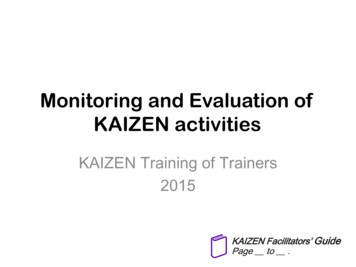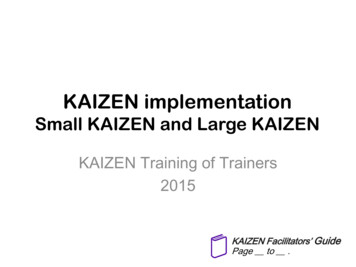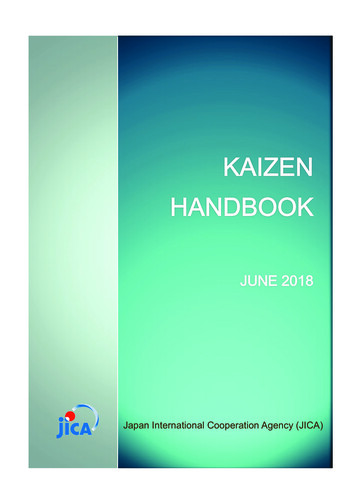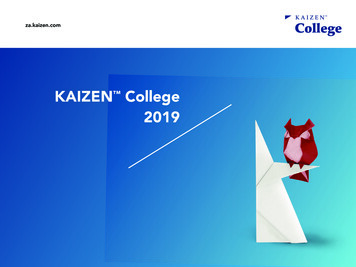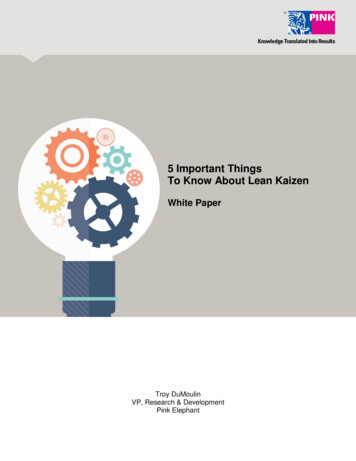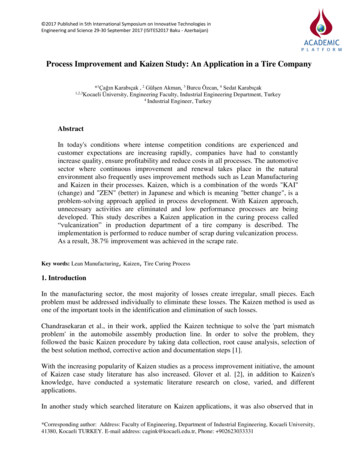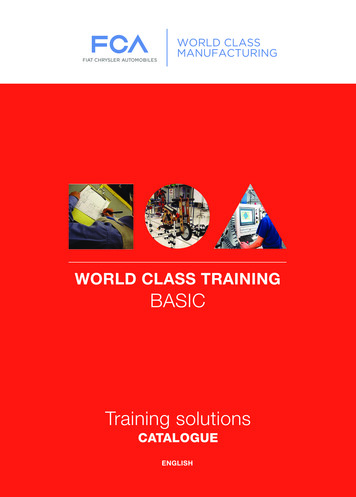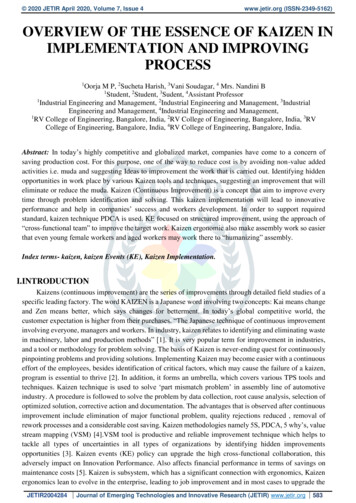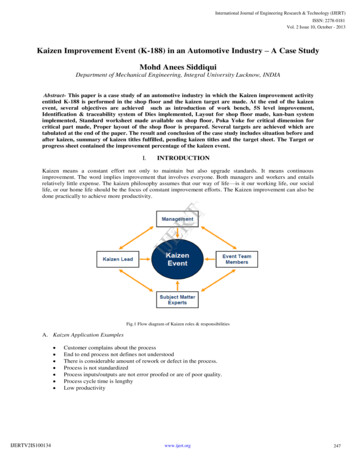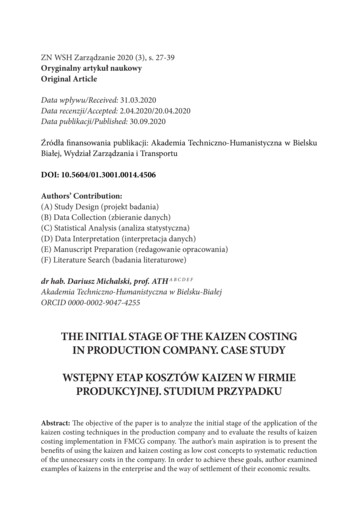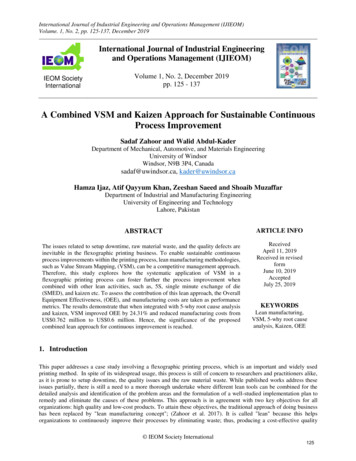
Transcription
International Journal of Industrial Engineering and Operations Management (IJIEOM)Volume. 1, No. 2, pp. 125-137, December 2019International Journal of Industrial Engineeringand Operations Management (IJIEOM)IEOM SocietyInternationalVolume 1, No. 2, December 2019pp. 125 - 137A Combined VSM and Kaizen Approach for Sustainable ContinuousProcess ImprovementSadaf Zahoor and Walid Abdul-KaderDepartment of Mechanical, Automotive, and Materials EngineeringUniversity of WindsorWindsor, N9B 3P4, Canadasadaf@uwindsor.ca, kader@uwindsor.caHamza Ijaz, Atif Qayyum Khan, Zeeshan Saeed and Shoaib MuzaffarDepartment of Industrial and Manufacturing EngineeringUniversity of Engineering and TechnologyLahore, PakistanABSTRACTThe issues related to setup downtime, raw material waste, and the quality defects areinevitable in the flexographic printing business. To enable sustainable continuousprocess improvements within the printing process, lean manufacturing methodologies,such as Value Stream Mapping, (VSM), can be a competitive management approach.Therefore, this study explores how the systematic application of VSM in aflexographic printing process can foster further the process improvement whencombined with other lean activities, such as, 5S, single minute exchange of die(SMED), and kaizen etc. To assess the contribution of this lean approach, the OverallEquipment Effectiveness, (OEE), and manufacturing costs are taken as performancemetrics. The results demonstrate that when integrated with 5-why root cause analysisand kaizen, VSM improved OEE by 24.31% and reduced manufacturing costs fromUS 0.762 million to US 0.6 million. Hence, the significance of the proposedcombined lean approach for continuous improvement is reached.ARTICLE INFOReceivedApril 11, 2019Received in revisedformJune 10, 2019AcceptedJuly 25, 2019KEYWORDSLean manufacturing,VSM, 5-why root causeanalysis, Kaizen, OEE1. IntroductionThis paper addresses a case study involving a flexographic printing process, which is an important and widely usedprinting method. In spite of its widespread usage, this process is still of concern to researchers and practitioners alike,as it is prone to setup downtime, the quality issues and the raw material waste. While published works address theseissues partially, there is still a need to a more thorough undertake where different lean tools can be combined for thedetailed analysis and identification of the problem areas and the formulation of a well-studied implementation plan toremedy and eliminate the causes of these problems. This approach is in agreement with two key objectives for allorganizations: high quality and low-cost products. To attain these objectives, the traditional approach of doing businesshas been replaced by "lean manufacturing concept"; (Zahoor et al. 2017). It is called "lean" because this helpsorganizations to continuously improve their processes by eliminating waste; thus, producing a cost-effective quality IEOM Society International125
International Journal of Industrial Engineering and Operations Management (IJIEOM)Volume. 1, No. 2, pp. 125-137, December 2019product for both manufacturers and consumers. A variety of lean tools can be used to improve productivity by eliminatingwastes within the process; (Abdualmalek et al. 2007).Nowadays, the main difficulty in the successful implementation of lean tools and concepts in any organization would bethe proper identification of problem area which needs improvements. So, an implementation based on inadequate orimproper visualization of the process may lead to an inconclusive lean journey. The studies of, (Ali-Asghar and Changiz2019; Zahoor et al. 2018, Yuvamitra et al. 2017; Alaya 2016, Edtmayr and Sunk 2016; Muzni and Ku Munirah 2015;Klabusayova 2014; Shook and Rother 2009; and Lasa et al. 2008), argued that value stream mapping while workingwithin a lean paradigm helps to improve the process by eliminating wastes. Furthermore, these authors mutually agreedthat VSM being the most promising among the other lean tools is capable to optimize the manufacturing organization asa whole.In this research work, a VSM approach combined with kaizen lean tool will be used to address the concerns raised by aflexographic printing industry with the aim to eliminate waste and increase the efficiency. This combined lean approachis supported by the use of 5-why for a thorough root cause examination of the problem areas needing improvements.More importantly, the overall equipment effectiveness metric is periodically measured during the study to ensure thatthe intended improvement is on track. The careful examination of the published works reveals that this comprehensiveundertaking to combine VSM, kaizen, 5-why, and OEE, has not appeared in the literature, and it is a step forward in thequest for continuous and sustainable improvement. More details will be provided and discussed in the next section aboutthe state-of-the-art of lean tools and applications.2. Literature ReviewThis section addresses the published literature on lean approach and continuous improvement. It includes papers thatapply lean concepts in various industries. The focus is on the concepts using VSM, VSM with other techniques, andmore importantly, on those papers that tackle the flexographic printing process. At this time, it is good to mention thatthe survival of any organization depends on its proficiency towards continuous process improvement in order to producevalue-added products and services for consumers. To achieve this goal, VSM has been employed by numerous industrialsectors from manufacturing organizations; (Tomes et al. 2015, Kuhlang et al. 2013, Tabassum and khan 2016) to variousother industries such as process companies; ( Zahoor et al. 2018; Rohani and Zahraee 2015; and Sattarova et al. 2016),maintenance departments; (Kasava et al. 2014), quality assurance; (Haefner et al. 2014), and materials flow; (Li et al.2017).Among others, Alvandi et al. (2012) emphasized on the importance of VSM application in the industry throughcomparing losses as icebergs and company itself as a ship. They argued that very small part of the iceberg is apparentwhile most of them are invisible under the sea. The real challenge is to identify them and VSM helps in this regards foralmost every industry via giving a top-down and a bottom-up survey of the process. As well, Sattarova et al. (2016),improved product cycle time when they utilized VSM as a lean tool in a manufacturing industry. They reduced the cycletime by 42.28% and costs by 57.71%. The authors further added that future work related to VSM can improve the processfurther. Klimecka-Tatar (2017), applied VSM to cardboard packaging production and made process improvements afteridentifying three major losses from the current state map. The study recommended that integration of lean principleswith VSM could be a good start for future improvements. Alternately, Yuvamitra et al. (2017), achieved continuousprocess improvements in a rope manufacturing industry through VSM integrated with the lean principles. The authorsrevealed that the modifications in the current state map made the process more efficient by reducing the manufacturingtime from thirty-six days to nine days only. The published literature also illustrates the significance of the VSM in theother fields as well. For instance, Kasava et al. (2015), demonstrated the application of the conceptual framework ofVSM as a sustainable manufacturing concept in an aircraft maintenance process. The operation was improved aftercategorizing the activities into "value-added" and "non-value-added” and they suggested an integration of otherimprovement tool with VSM for the future improvements of the process. In separate work, Haefner et al. (2014), usedVSM in the context of quality assurance issues. They called this a quality value stream mapping (QVSM). This tool isideal for 1) visualization, 2) analysis and 3) quality assurance design.There are various researches that demonstrate the enhanced competency of VSM for sustainable improvements whenused with other lean tools as a joint approach to suggest improvement changes. Among these efforts, Tabassum and Khan(2016), presented a case study on the effective utilization of VSM to identify the bottlenecks in the assembly process ofan automotive manufacturing unit. These authors, thereafter used the 5S technique to organize a poorly designedworkspace, which consequently brought a 62% improvement in the assembly line efficiency. Similarly, Rohani andZahraee (2015), improved the production line of a colour manufacturing industry after differentiating the “value-added” IEOM Society International126
International Journal of Industrial Engineering and Operations Management (IJIEOM)Volume. 1, No. 2, pp. 125-137, December 2019and the “non-value-added” activities through VSM. Furthermore, “non-value added” events were eliminated by using5S and Kanban which led to the reduction of the production lead time by 6 days from 8.5 days.In another work, Azizi and Manoharam (2015), employed an integrated lean approach to improve the machine set-uptime for a printed circuit board (PCB) assembly line. These authors, after identifying the hidden losses in the currentstate map of the process, applied kaizen and SMED, as a lean concept. This approach resulted in the reduction of set-uptime from 145 seconds to 54 seconds. Likewise, in one of our work, Zahoor et al. (2018), analyzed the current state of agear manufacturing unit using VSM. It helped when joined with kaizen to improve the lead time from 528 minutes to132 minutes. Similarly, Batra et al. (2016) made an attempt to reduce the waste within a tool room of an automotiveindustry using VSM. The authors argued that VSM correctly identified the areas for the improvements and bridged thegap between the current and the future state of the process using a lean approach: Jishuken (self-learning).There is a literature pertaining to the use of computer simulation to take into accounts of all VSM outcomes (Alvandi etal. 2012; Li et al. 2017; Chukukere et al. 2014; and Standnicka and Antonelli 2015). While working for an aluminumrecycling facility, Li et al. (2017), utilized a Sanky diagram for VSM to evaluate and visualize the complex flow ofenergy and materials in the manufacturing system. They embedded this diagram with the existing ERP software for thecontinuous analysis. Similarly, Stadnicka and Antonelli (2015), employed FlexSimTM simulation software to mapcurrent and future state of a sleeve manufacturing process. The authors argued that computer simulation could providean opportunity to get a deeper insight of the process but preparing the model for the software is itself a time and costconsuming process. So, decision regarding the use of software simulation for a particular case would be a critical step.Although, these researches provide clear evidence to support the significance of VSM and its integration with other leantechniques in many manufacturing sectors, one of the major inadequacy that can be observed in almost all the reviewedpapers, is the absence of using a common performance metric to benchmark any process performance such as OEE anduse of an additional root cause analysis to strengthen the VSM effectiveness; (Dadashnejad et al. 2019; Zarwan 2017).In another attempt, Munyai et al. (2019), employed simulation-based VSM to enhance the productivity for a shaftmanufacturing industry. The results revealed an increment in the throughput of two identified bottleneck operations by27% and 60.74%, respectively.Of the work, fewer case studies are found related to the lean application to improve the flexographic printing process. Itincludes Bodolay (2010), who presented a case study of this printing method. Bodolay employed two different lean tools,i. e., 5S and single minute exchange of die, to reduce the downtime and improve the throughput of the process. Theseimprovements resulted in an additional 70 hours of productivity, saving more than 3 million annually. In a differenteffort, Zahoor et al. (2017), improved the OEE from 34% to 40.2% using pareto and 5-why root cause analysis as a leanapproach. Lipiak (2017), in his work, attempted to enhance the process effectiveness through the use of SMED andquality function deployment. The author further recommended the use of other available lean methodologies, which canidentify the opportunities for the improvements within the existing process. Unfortunately, no one has employed VSMas a lean approach to improve the flexographic printing operation. Therefore, this work seeks to contribute to the literatureabout a widely applied concept of VSM integrated with kaizen and 5-why analysis with the focus to improve the OEEof this process along with the production cost.The remainder of the paper is organized as follows: Section 3 describes the flexographic printing process and presentsdetails about the various steps that constitute the printing process. Section 4 covers the combined lean manufacturingapproach where value stream mapping, 5-why, and kaizen activities are featured and used. Lastly, the conclusion andrecommendations for future research are stated.3. Flexographic Printing Process Description and Related ProblemsA flexographic printing machine used in a renowned packaging organization is considered as a case study. Theparagraphs below present a detailed description of this widely used printing method. The machine specifications and theproduction capacity are listed in Table 1.Table 1: Flexographic printing machine specificationsMachine nameKey raw materialMachine speedType of printing processActual production(meters/min)(meters/ year)Cerruti GreenPET, Polyester,220In-line flexographic80 millionPVC and BOPPprintingThe schematic of the various components of the printing machine under study is shown in Figure 1. There are nine basicsteps involved in the flexographic printing process explained below: IEOM Society International127
International Journal of Industrial Engineering and Operations Management (IJIEOM)Volume. 1, No. 2, pp. 125-137, December 20191.2.3.4.5.6.7.8.9.Unwinding of poly film and passing through the plate cylinder and the impression cylinder.Filling of the mixture of ink and the solvent in the ink tray.Extraction of ink from the tray by the fountain cylinder.Transfer of ink from fountain cylinder to the anilox cylinder.Distribution of ink across the emerged areas of the plate cylinder that causes printing.Pasting of a uniform layer of the ink from the anilox cylinder to the soft plate/flexible plate cylinder.Uniform distribution and removal of the excessive ink by the doctor blade on the anilox roller.Printing on the substrate by the plate cylinder against the impression cylinder.Finally, the printing will be completed by the impression cylinder through exerting the pressure.Figure 1: Schematic of the flexographic printing processThe following section will be dedicated to the approach tackling the above-indicated process shortcoming where details,explanations, and different metric measurements will be carried as per the proposed combined lean approach.4. MethodologyTo accomplish the objectives of this research, direct data collection method was used for the better understanding of theexisting process; (Dadashnejad et al. 2019; Alaya 2016; and Thomas 1994). While using this method, thoroughinformation related to the process downtime was gathered after the careful examination of the printing operation, andcollected data was utilized to map the current state and identify the problem areas. Furthermore, semi-structuredinterviews with the production manager, the supervisor, and the operators were carried out in order to answer thequestions for the root cause analysis of identified areas. The respondents were questioned to indicate the issues andpossible causes related to the process stoppages and the other losses. Additionally, suggestions were invited from thestaff in order to design appropriate kaizen routines. Moreover, the VSM awareness talks and workshops were organizedin the company under consideration. Upon the compilation of the data, the following two main concerns were noted:machine downtime and final print quality. These two concerns have a direct impact, and negatively affect the metricOEE.To address these process’s weaknesses, the VSM as a lean approach is employed methodically to assess its impact onthe OEE. During the first step, the flexographic printing machine was selected and the OEE of the current situation wasevaluated as follows:OEE Quality Availability PerformanceIn the second step, the current state map was formulated based on the acquired data. In order to ensure the best VSMperformance, it is advisable to conduct an additional root cause analysis. Therefore, upon recognizing the problem areasfrom the current state map, the 5-why analysis was performed to identify the root cause of these problems. It facilitatesand strengthens the diagnostic of the process by identifying the exact cause of the problem. The work plan for the IEOM Society International128
International Journal of Industrial Engineering and Operations Management (IJIEOM)Volume. 1, No. 2, pp. 125-137, December 2019improvement was then proposed in the third step using kaizen. Kaizen is used for the continuous improvement byfocusing on the impactful small incremental changes and sustaining them for a long period of time by involving everyonein the organization; (Nguyen 2019; Akhter et al. 2015). It is a simple and inexpensive approach which can improve theefficiency and the productivity of the process. The fourth step involved the mapping of the future state incorporatingeach improvement routine. Improved OEE measurement based on the future state map was calculated followed by theproduction cost estimation. Lastly, the fifth step comprised of successful implementation of the work plan. To confinethe kaizen practices during the implementation phase, a unit-functional team was established which worked togetherwith the quality circle that already existed in the company. The schematic of the combined lean journey is shown inFigure 2.Figure 2: The combined lean journey5 Results and Discussion5.1 Current State MapA current state of the process was mapped based on the collected data and is shown in Figure 3. It includes the productionflow of the printing operation starting from the customer order to the finished product. From the map, four process stepswere marked as experiencing stoppage losses. The summary of these process steps with recorded downtime is given inTable 2 below.Figure 3: Current state map IEOM Society International129
International Journal of Industrial Engineering and Operations Management (IJIEOM)Volume. 1, No. 2, pp. 125-137, December 2019Table 2: Summary of printing steps experiencing stoppage lossesProcess stepTotal downtime(hours/year)Cylinder fault137.5Electrical breakdown142.5Air pasting problem178.0Ink shade problem205.0On the basis of the available downtime data, the OEE for the existing process (current situation) was calculated and ispresented in Figure 4.Figure 4: OEE calculation based on the current stateThese printing steps were made out as problem areas which negatively impact the equipment availability. To diagnosethe root cause of these identified problem areas, the 5-why analysis was carried out as shown in Figure 5. In this paper,the asking of "why" question was stopped after the third time because the root cause was clearly identified. The literaturealso confirms the same; (Zahoor et al. 2017; Alukal 2007; and Benjamin et al. 2010) that there is no need to further askthe "why" question if the root cause has been identified earlier. The results obtained after the 5-why analysis are givenin Table 3.(a) 5-why analysis for cylinder fault(b) 5-why analysis for electrical breakdown IEOM Society International130
International Journal of Industrial Engineering and Operations Management (IJIEOM)Volume. 1, No. 2, pp. 125-137, December 2019(c) 5-why analysis for air pasting problem(d) 5-why analysis for ink shade problemFigure 5: 5-why analysis of identified problem areasProblem areaCylinder FaultElectrical BreakdownAir Pasting ProblemInk Shade ProblemTable 3: 5-why analysis resultsCause and effectsCause: Improper setting/alignment of impressionroller cylinder due to worker negligenceEffect: Duplicate printingCause: Short-circuiting at the workplaceEffect: Process breakdownCause: Looseness in the doctor bladeEffect: Grainy dots on impression patternsCause: Reducing ink sticky effectsEffect: Fade printingTo eliminate these issues which were causing process downtime; a work plan for improvements will be proposed in thesubsequent section.5.2 Proposed Work PlanUpon identifying the root cause of these problem areas, different strategies for their improvement were proposed, (Table4) to reduce the machine downtime. Kaizen was adopted to further elaborate the action plan for the comprehensiveimplementation of these routines.Table 4: Strategies for improvementsProblem areasImprovement strategiesOperationHousekeepingCapital investment inStaffstandardizationmodern equipmenttrainingCylinder fault Electrical breakdown Air pasting problem Ink shade problem A detailed description of the improvement routines suggested by kaizen is presented below:1.Operation standardization and housekeeping: The current state map, (Figure 3), and 5-why analysis, (Figure 5),show that downtime can be reduced by standardizing the work method. This should be done by implementing apreventive maintenance schedule. To avoid the cylinder fault, a weekly inspection of the polishing and the waxingof the impression roller was recommended. As far as the electrical breakdown concerned, dedicated wire groutingwas advised to prevent short-circuiting within the working area. Daily inspection of electrically related housekeepingshould be incorporated within the preventive maintenance plan. Similarly, the examination of the air pasting pressureproblem to avoid the looseness in the blade was suggested as a prime section of the maintenance schedule. Tostandardize the ink shade mixing process, display of the colour composition and pattern charts for the proper mixingof ink shade was appreciated. Furthermore, to avoid the delays in the process due to ink shade variations, the usageof a uniform number of lines/inch of the anilox cylinder at the ink supplier and the packaging manufacturer end wasrecommended. IEOM Society International131
International Journal of Industrial Engineering and Operations Management (IJIEOM)Volume. 1, No. 2, pp. 125-137, December 20192.Capital investment in modern equipment: The use of modern technology can eliminate the process downtime.Therefore, the following new machine set-ups were suggested for these specific problems: 3.The installation of a new doctor blade was advised for the reason that when used in series with the old one,it can support the better wiping of ink and the uniform transfer of the ink on the substrate. This arrangementwill not only improve the grainy dots issue on the samples but also extend the life of the doctor blade aswell.The difference in the material of the drawdown sample (the glass screen on which the shade sample is takenbefore the final printing) and the actual poly film substrate (on which the final printing is done) results inthe ink shade variation in the final printing. These variations could be eliminated through purchasing a newdedicated equipment to take the drawdown sample. It uses the same poly film material instead of the glassscreen.Ethyl acetate is used as a solvent to clean the ink drums, from which the printing rollers take ink, andtransfer it to the substrate. Previously, fresh ethyl acetate was used for this purpose which consumed areasonable amount of capital. Moreover, the scarcity of the fresh solvent in the market caused furtherprocess delays. To reduce the consumption of the fresh solvent and ensure its continuous availability, asolvent recovery plant was proposed to recycle the solvent from the ink waste. Table 5 illustrates the costthat can be saved after installing the solvent recovery plant.Staff training: The awareness and the training sessions for the workers were recommended to maintainsustainability in the improvement process. This enables the employees to take part in the lean implementation byproviding a specific skill level; (Bhasin 2012).Table 5: Cost based comparison of the solvent recovery plantBefore the solvent recovery kg(US )1.761067041.76Costin million(US )0.23Amount of freshsolvent used100%Amount ofrecycledsolvent0%After installation of the solvent recovery plant0.1824%76%RemarksCompletely dependent onthe costly fresh solventSavingUS 0.05 million5.3 Future State MapAfter incorporating all the kaizen activities, the future state of the process was mapped as shown in Figure 6. Theimproved state indicates a reduction in the downtime associated with all the marked operation steps. The comparison ofthe OEE metric between the improved state and the current state of the printing operation will be presented in thesubsequent paragraph. IEOM Society International132
International Journal of Industrial Engineering and Operations Management (IJIEOM)Volume. 1, No. 2, pp. 125-137, December 2019Figure 6: Future state mapThe future state map shows the reduction in the downtime for all the identified issues, (see Table 6 below). The drop inthe machine downtime is evidence of the success of this proposed combined lean approach. It also reveals that VSM isequally capable in targeting the specific areas for the improvement in case of the flexographic printing process, which isin agreement with the other published researches related to the different industrial sectors; (Tomes et al. 2015; Kuhlanget al. 2013; Tabassum and khan 2016; Rohani and Zahraee 2015; and Sattarova et al. 2016). Moreover, it is noted thatthe VSM is well supported by the root cause analysis in revealing the exact cause of all these identified problems. As aresult, this analysis facilitated the process in suggesting the improvements. The published works can be found in thesustenance of 5-why significance; (Zahoor et al. 2017; Benjamin et al. 2010). For example, Benjamin et al. (2010), usedthis approach to find out the main reasons for the waste in the Toyota production system. The authors referred to the 5why analysis as a realistic approach for the identification of the prime cause of an issue to reduce and eliminate thedefects.The improvement in the downtime also proves that the kaizen, not only achieved the objectives with respect to the processdowntime but also carved a path towards a sustainable continuous improvement. The achieved results are supported byseveral studies; (Nguyen 2019; Zahoor et al., 2018; Rahmanian and Rahmatinejad 2015; and Jamian et al. 2012). Forinstance, Nguyen (2019), proved that kaizen offered a competitive edge towards sustainable developments for the SMEsin Vietnam. Similarly, Rahmanian and Rahmatinejad (2015), concluded that manufacturing companies can use kaizenapproach for their growth and survival.Table 6: Downtime improvement in the flexographic printing processProblem areaCurrent downtimeImproved downtimeSaved downtime(hours/year)(hours/year)(%)Cylinder fault137.58538.2Electrical breakdown142.535.575Air pasting problemInk shade problem178205116.5115.534.643.7The corresponding improvement in the availability of the equipment and OEE followed by the production cost estimationis shown in Figure 7. As, the future state map showed a reduction in the process downtime (Table 6), followed by theimproved OEE, (Figure 7), this combined lean approach was strongly recommended to ensure the continuous processimprovement of this printing machine. IEOM Society International133
International Journal of Industrial Engineering and Operations Management (IJIEOM)Volume. 1, No. 2, pp. 125-137, December 2019Figure 7: Improved OEE calculation6. Conclusion and Recommendations for Future ResearchThis paper demonstrates the usefulness of lean manufacturing concepts and highlights how it can be utilized to improvethe overall equipment effectiveness of a flexographic printing process. It also establishes the significance of the proposedcombined lean approach using VSM, 5-why root cause analysis, and kaizen. This approach proved to be effective withregard to introducing improvement routines for the future state map and ensuring continuous process improvement.In this study, the main practical objective was to improve the OEE with the focus to enhance the machine’s availabilityby reducing the downtime. The following inferences were drawn:1.2.3.4.The standardization of the machine operations work method led to a significant machine downtime reduction of 75% (electrical problems) and 38% (cylinder fault problems).The results of the research also inferred that the capital investment for the suggested equipment set-up could cutdowntime by 34.6% and 43.8% for air pasting and ink shade problems, respectively, thus, making the entire processmore efficient and productive.As stated earlier, lean manufacturing aims to bring a positive and continuous impact on the process. This studydemonstrates the success of the lean approach applied to the production flow of a flexographic printing operation.The suggested kaizen improvements would enhance the availability of printing equipment by 23.65% through thereduction of downtimes. Consequently, the OEE would improve by 24.31%.The cost saving based on the improved OEE for the next production year was estimated to be between US 0.762million to US 0.60 million.While the case study and its findings relate to a specific industry, flexographic printing, the combined and comprehensiveapproach used can be applied to other manufacturing industries. As future
gear manufacturing unit using VSM. It helped when joined with kaizen to improve the lead time from 528 minutes to 132 minutes. Similarly, Batra et al. (2016) made an attempt to reduce the waste within a tool room of an automotive industry using VSM. The authors argued that VSM correctly identified the areas for the improvements and bridged the
